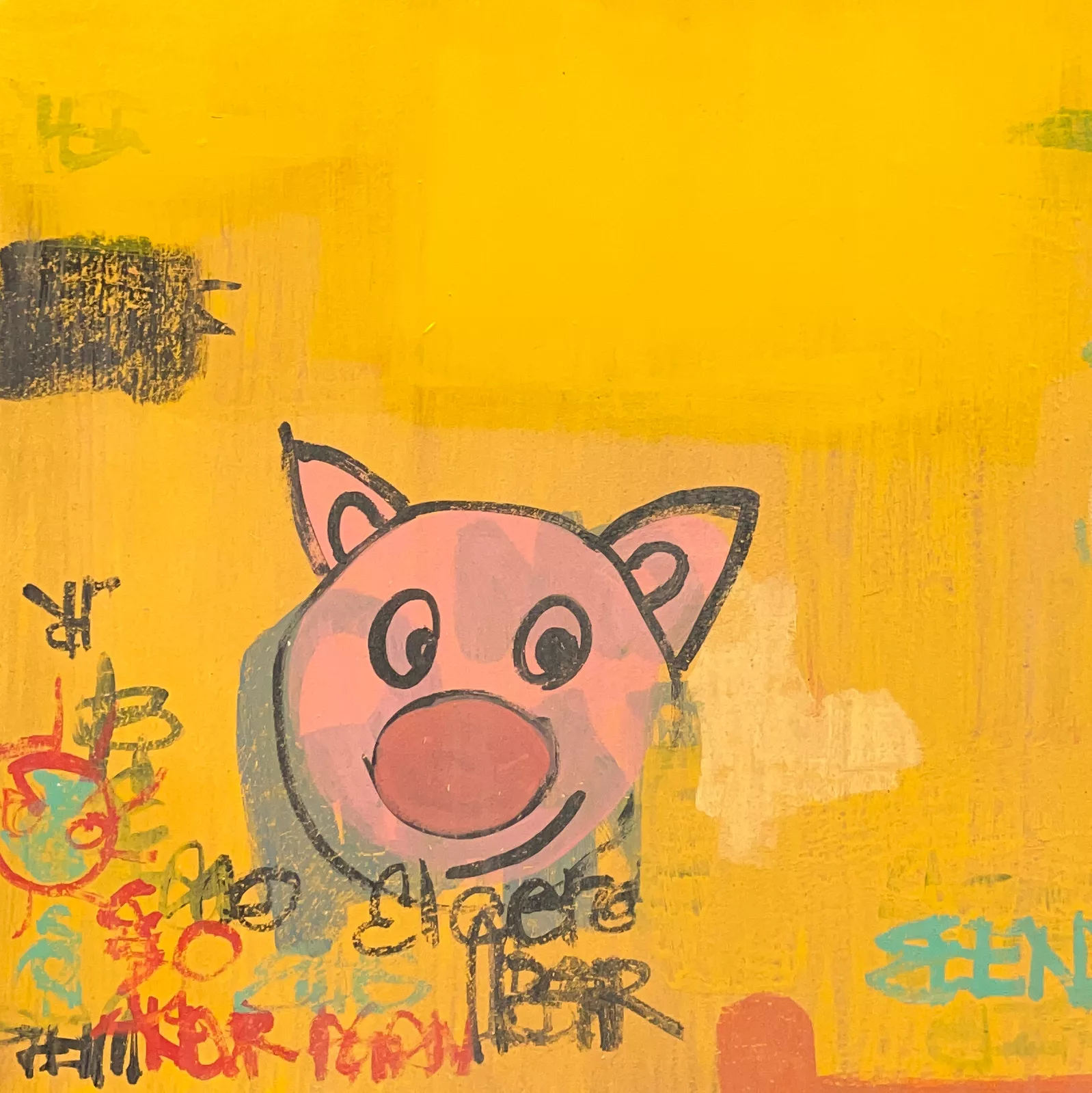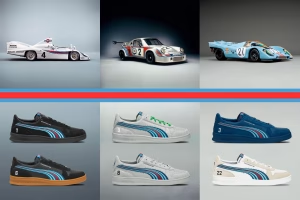In the ever-evolving world of modern art, where the lines between high and low culture are constantly blurred, there’s something uniquely captivating about the work of artists who find beauty and meaning in the everyday. One such artist is Spanjer, whose playful and vibrant depiction of Charms Blow Pop lollipops in pop art form brings together childhood nostalgia, consumer culture, and artistic expression in one colorful package. This particular piece, featuring three lollipops against a pink backdrop, is not just a work of art—it’s a commentary on the intersections of consumption, memory, and modern aesthetics.
At first glance, Spanjer’s artwork feels like an invitation to take a trip down memory lane. Who doesn’t remember the delight of unwrapping a Blow Pop, savoring the sugary hard candy shell before reaching the bubblegum center? In this way, the painting immediately connects with viewers on a visceral, emotional level. Yet beyond its nostalgic subject matter, the piece serves as an exemplary example of the pop art movement’s ethos: taking mass-produced, everyday objects and elevating them into something worthy of artistic contemplation.
A Connect of Realism and Abstraction
What makes this piece by Spanjer so intriguing is the careful attention to detail paired with the abstract, flattened aesthetic characteristic of pop art. The lollipop wrappers, for instance, feature distinct gray twists that appear almost three-dimensional. This meticulous rendering of a mundane detail—one that viewers may have never consciously noticed—gives the piece a sense of tangibility. The wrappers’ texture contrasts starkly with the otherwise smooth and simplified elements of the painting, drawing the eye toward the lollipops and imbuing them with a lifelike quality.
At the same time, the piece maintains a graphic and stylized approach. Each lollipop is outlined with a bold white border, emphasizing their cartoonish, almost exaggerated form. This visual strategy—a hallmark of pop art—creates a striking contrast between the realistic elements of the lollipop and the deliberately flattened aesthetic of the overall composition. It is this juxtaposition of the real and the surreal that captures the essence of the pop art movement, a genre that often seeks to challenge traditional notions of what qualifies as “fine art.”
The Playful Use of Color and Texture
A key aspect of Spanjer’s success in bringing this piece to life is the bold use of color and texture. The pink background is not just a backdrop—it’s a hand-painted expanse with thick, uneven paint application, which adds a sense of physicality and depth to the work. The thick layers of paint contribute to the artwork’s dimensionality, ensuring that it feels like more than just a flat image on a wall. Instead, the piece comes alive, almost as though the lollipops are within reach.
The use of pink as the dominant color is also worth noting. In the world of consumer goods, pink has long been associated with sweetness, innocence, and femininity, which ties in perfectly with the nostalgic and childlike subject matter of the lollipops. However, the choice of pink also carries more subversive connotations in pop art, where artists have historically used bright, “non-serious” colors to challenge societal expectations of what art should look like. In Spanjer’s piece, pink becomes a powerful visual tool that draws the viewer in while also emphasizing the playful, whimsical nature of the work.
Additionally, the thick application of paint contrasts beautifully with the clean, precise outlines of the lollipops, creating an interesting dialogue between texture and form. The textural quality of the background gives the piece a tactile feel, while the flat, graphic depiction of the lollipops remains simple yet bold. This interplay between texture and flatness is central to the visual impact of the piece and mirrors pop art’s fascination with both realism and abstraction.
Commentary on Consumer Culture
While at first glance, Spanjer’s piece might seem like a lighthearted celebration of a childhood favorite, it also invites deeper reflection on the nature of consumer culture. Pop art has always been concerned with the commodification of everyday objects, and the Charms Blow Pop is no exception. By elevating a mass-produced candy into a subject worthy of artistic representation, Spanjer encourages viewers to think about the role that consumer products play in their lives.
The lollipop, a cheap and easily accessible treat, becomes a symbol of the way consumer goods are marketed, sold, and consumed in modern society. In this sense, the painting serves as a commentary on how such objects are not just commodities, but cultural artifacts that carry meaning and significance beyond their intended use. In much the same way that artists like Andy Warhol used images of Campbell’s soup cans and Coca-Cola bottles to explore the relationship between art and commerce, Spanjer’s Blow Pops can be seen as a reflection on the ways in which consumer goods shape our experiences and memories.
This commentary is amplified by the fact that the Blow Pop is not merely a generic lollipop—it’s a specific brand, instantly recognizable by its colorful packaging and bubblegum center. The branding and marketing of Charms Blow Pops have played a significant role in embedding the product into the collective memory of a generation. By choosing such an iconic subject, Spanjer highlights the power of branding and consumerism in shaping culture and memory.
The Power of Nostalgia
At the heart of Spanjer’s work is the potent force of nostalgia. The depiction of Blow Pops, an iconic candy from many people’s adolescence, taps into a sense of longing for simpler times. For many viewers, the piece likely evokes memories of childhood trips to the corner store or the excitement of receiving a lollipop after a doctor’s visit. This emotional connection between the viewer and the subject matter is a key element of the work’s appeal.
Nostalgia is a powerful tool in art, as it allows viewers to engage with a piece on a deeply personal level. In Spanjer’s painting, the Blow Pops become more than just candy—they represent moments of joy, innocence, and carefree indulgence. This emotional resonance is what makes the piece so much more than a mere depiction of a commercial product. It’s a celebration of the small, simple pleasures in life and a reminder of the power of memory in shaping our experiences of the present.
BIG Wall Décor’s Commitment to Quality
Behind Spanjer’s work is BIG Wall Décor, a company committed to producing high-quality, large-scale modern wall art. Their mission is to offer art that not only elevates the aesthetic of any environment but also stands the test of time. In partnering with artists like Spanjer, BIG Wall Décor is able to bring unique, playful, and culturally relevant pieces to a wider audience.
The company’s dedication to craftsmanship is evident in the production of Spanjer’s work. Each piece is carefully crafted to ensure vibrant colors, crisp details, and lasting durability, ensuring that the art retains its visual impact over time. Moreover, BIG Wall Décor’s focus on customer satisfaction means that every artwork is created with the viewer in mind, offering pieces that are both visually stunning and emotionally resonant.
A Whimsical Celebration of Art and Culture
Spanjer’s depiction of Charms Blow Pop lollipops is a playful, vibrant, and thought-provoking piece of pop art that engages with the viewer on multiple levels. From its nostalgic subject matter to its commentary on consumer culture, the artwork exemplifies the key elements of the pop art movement while also standing out as a unique and memorable work. Whether viewed as a celebration of childhood delights or a reflection on the commodification of modern life, the piece captures the joyful, whimsical spirit that defines both Spanjer’s style and the mission of BIG Wall Décor.
No comments yet.








